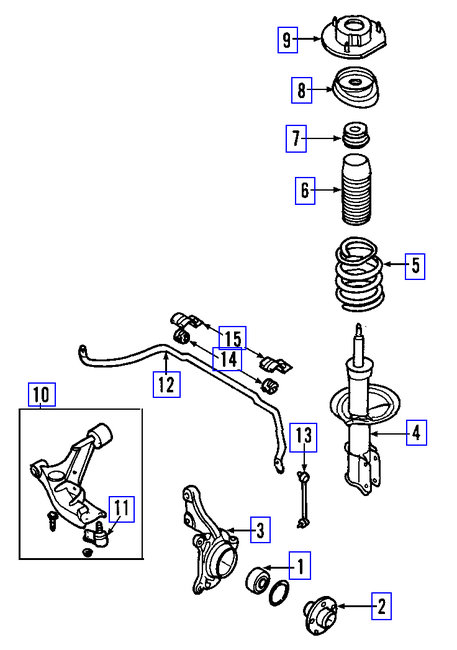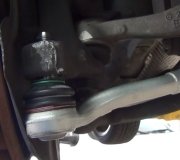The car has to be aligned when suspension parts are replaced. The only time that might not be necessary is when you have a round ball joint that is pressed or screwed into the control arm. With that design, you can only be putting the parts back into the same orientation as the old one was before it wore out.
When you have a bolt-on ball joint, which GM commonly used on their upper control arms on older cars, and especially when you have this newer design where you're forced to replace the entire control arm, it is impossible to get any two arms that are exactly the same. Production tolerances allow for slight differences in lengths, and by placing a ball joint in a different location, even by as little as 1/32", that changes the alignment.
The first of the three main alignment angles is "camber". That is the inward or outward tilt of the wheel as viewed from in front of the car. If your new lower control arm is slightly longer than the old one, that moves the lower ball joint out, and causes the wheel to tip in on top a little, or tip out a little less than it was before. That is the first angle that is adjusted during the alignment. Camber causes a tire to want to pull in the direction it is leaning. Each wheel must be adjusted to specs to reduce tire wear on the inner or outer edges, and both sides must be very nearly equal so the pulls offset each other and the car goes straight when you let go of the steering wheel.
"Caster" is the next angle, but it is almost totally irrelevant on front-wheel-drive cars. It doesn't contribute to a pull like it does on rear-wheel-drive cars and trucks, and it contributes very little to tire wear. On front-wheel-drive cars it is the main angle that affects how well the steering wheel returns to center after going around a corner, and it contributes to steering effort. The best way to visualize caster is to look at the fork of a bicycle and how it is angled rearward at the top. By placing your weight on the bike, that caster is what makes the front wheel squirt out to the front so you can ride no-handed. The weight of the car is what causes caster to make both front wheels want to turn toward the center of the car. Connecting the wheels with the steering linkage offsets the forces on the two wheels and makes them equal when they're straight ahead.
The third main alignment angle is "toe". That is the direction the wheels are steering when the steering wheel is straight. This angle also changed when you replaced the control arms. If you think of the lower ball joint as the pivot point, similar to the wheel of a wheelbarrow, and the upper steering pivot, the upper strut mount on your car model, the steering arm on the spindle would equate to the load in the wheelbarrow. When the wheel hits a bump and moves up an inch, your hands didn't move, and the load only moved up perhaps three quarters of an inch. Similarly, on your car, the upper strut mount doesn't move, but with the new control arm, suppose the lower ball joint has moved out 1/8". That moved the lower end of the spindle out 1/8", and the steering arm maybe 1/16". On the alignment rack, the mechanic is going to have to adjust that tie rod assembly 1/16" longer to bring that wheel back to the correct toe setting. We can get down to much more precision that 1/16". I had my computer set up to read to the hundredth of an inch.
Another problem is often caused by competent do-it-yourselfers when they replace steering and suspension parts with rubber bushings. The car is raised up on a hoist or is supported on jack stands with the suspension hanging down. If new parts are installed that way and the bolts are tightened to specs, when the car is lowered onto the tires, those suspension parts angle up to their normal at-rest positions. With the bushings already clamped tightly in place, that movement back to their normal positions puts those bushings in a permanent twist that will greatly shorten their life. Instead, the bolts for the new parts must be left loose at first. I would drive the vehicle around the shop's parking lot to settle the new bushings. At a minimum, you want to bounce the car by hand a few times. Once that is done, you have to crawl under the car and tighten the bolts to the proper torque specs while it is sitting at normal ride height. If this applies to you, rather that starting all over, tell your mechanic which parts you replaced, and ask him to simply loosen and retighten the bolts while the car is sitting on his drive-on alignment hoist. That will let those bushings snap back to remove any twist.
That twist can also cause the bushings to act like springs that are trying to lift the front of the car up. With such a light car, you may be able to measure that. All repair shops have a small book that lists every car model and year, what the legal, published height specs are for it, and where to take those measurements. All newer alignment computers also have that information and most even have provisions for taking those measurements during the alignment. While correct ride height is less important on cars with strut suspension, it is critical for best tire wear on cars with other types of suspension systems. For those, if ride height is not correct, typically from sagged springs / age, you will have miserable tire wear even though the numbers on the alignment computer look perfect.
Please keep me updated on your progress.
For others researching this topic, here's a link to a related article:
https://www.2carpros.com/articles/popping-noise
Tuesday, September 1st, 2020 AT 4:26 PM



